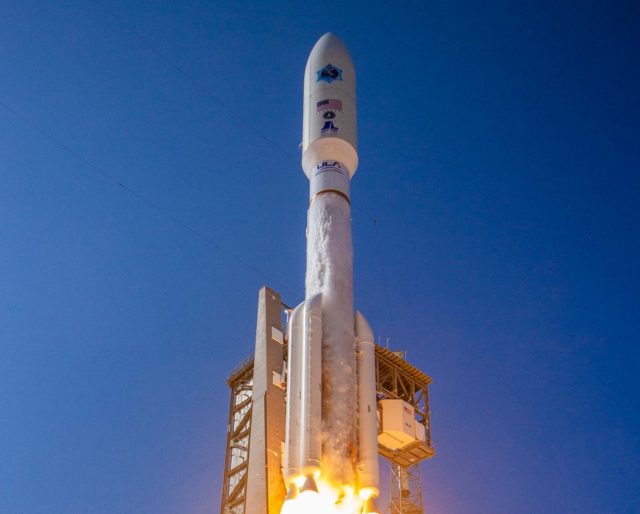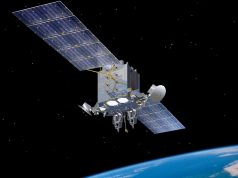
The Advanced Extremely High Frequency (AEHF) satellite constellation that will be operated by the US Space Force has been declared operational after a 20-year undertaking.
The satellite control authority of the sixth and final satellite in the constellation transferred to the operators (Space Delta 8 and 4th Space Operations Squadron) on October 29, 2020. Operational acceptance was authorized by Space Operations Command on December 28, 2020, and will be fully integrated into the user community later this year.
AEHF is a joint-service communications satellite providing survivable, global, and jam-resistant communications for high-priority military ground, sea and air assets in the latitudes located 65 degrees above and below the equator.
Besides the US, the system provides protected satellite communications to Canada, United Kingdom, Netherlands and Australia. AEHF allows the National Security Council and Unified Combatant Commanders to control their tactical and strategic forces at all levels of conflict through general nuclear war and supports the attainment of information superiority.
“Thank you to the amazing men and women who have worked tirelessly over the years on this extremely important program,” said Lt. Gen. John Thompson, Space and Missile Systems Center commander and program executive officer for Space. “Your efforts contributed immensely to our successes downrange and keeping our warfighters and allies out of harm’s way.”
The AEHF system is the follow-on to Milstar, and augments and improves the capabilities of the Milstar satellites – expanding the MILSATCOM architecture. AEHF provides 10 times more throughput of the 1990s-era Milstar satellites with a substantial increase in coverage for users. The combined Milstar/AEHF constellation operates in geosynchronous Earth orbit and provides connectivity across the spectrum of mission areas, including land, air and naval warfare; special operations; strategic nuclear operations; strategic defense; theater missile defense; and space operations and intelligence.
“This program evolved over time to provide a continued, relevant and resilient capability to the nation’s space strategy,” said Marcus McInnis, the final AEHF program manager. “The AEHF Program saw many challenges and in the end, represents a huge success. We were able to meet seemingly impossible challenges at times to deliver the future capabilities needed by the US and its warfighters.”
“Different eras produce different priorities and we now must field for a contested and congested domain,” Thompson said. “Costs and schedule aren’t the only factors anymore. Our willingness to experiment and transition away from major stove-piped programs enable us to produce with speed and at scale. The AEHF program demonstrates this diversified and flexible approach to meet the warfighter’s needs.”
Program successes did not come easily. AEHF-1 launched in 2010 and immediately had orbit raising issues. The space vehicle’s Liquid Apogee Engine, which is used to position the satellite into geostationary orbit, malfunctioned. The government, aerospace and Lockheed Martin teams worked around the clock for several months to find a viable solution that allowed the space vehicle to meet its performance goals and played an important part in the evolution of the Milstar/AEHF constellation into what it is today.
“AEHF program’s success was only possible because of the strong partnership between government and industry partners from the very beginning,” said Cordell DeLaPena, program executive officer for Space Production. “Working closely with Lockheed Martin, we were able to procure the fifth and sixth AEHF satellites as one buy, resulting in a savings of more than $1 billion to the taxpayers.”
More recently, the final AEHF satellite was launched in March 2020 with the distinction of being the very first US Space Force mission. Additionally, the team had to overcome challenges of being the first launch under COVID-19 restrictions. Deemed ‘Mission Critical’ for the warfighter, the AEHF team re-worked procedures, capabilities and work environments to ensure Launch, Orbit-raising, and On-Orbit Test personnel were safe and could continue to operate effectively.
“It was through excellent teamwork with SMC’s industry partners and the center’s long and successful relationship with them that made it possible for the program to adapt, succeed and bring this historic chapter to a close,” said Col. John Dukes, Space Production Corps division chief for Geosynchronous/Polar Orbit programs. “The AEHF era has been a truly notable accomplishment.”
Lockheed Martin Space Systems is the prime AEHF contractor and systems integrator of the satellite while Northrop Grumman Aerospace Systems provided the payload.
“This is truly a bittersweet moment for those who have worked on this program for years helping to ensure our National Security,” said Lt. Col. Paul LaTour, former AEHF Program Manager/Material Leader and current Program Manager/Material Leader on the new Evolved Strategic SATCOM program. “But now, we get to look towards the ESS Program which represents another exciting leap forward in the evolution of MILSATCOM.”
The new ESS program is the next generation of protected communication satellites that will interoperate with, and eventually replace AEHF’s mid-latitude system, extending its communications capability to the North Polar Region. Lockheed Martin, Boeing and Northrop Grumman will be developing competing designs for the ESS program in a rapid prototype phase over the next few years. Contracts for the full ESS system are expected to be awarded in 2025.

























